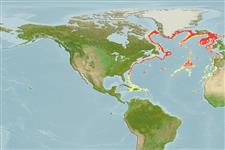Environment: milieu / climate zone / depth range / distribution range
Écologie
marin bathydémersal; profondeur 365 - 1700 m (Ref. 4460). Deep-water; 66°N - 17°N, 78°W - 0°E
Eastern Atlantic: Greenland and Iceland southward to 17°N. Western Atlantic: Greenland to Grand Banks and 29°52'N, 77°09'W.
Length at first maturity / Taille / Poids / Âge
Maturity: Lm 55.0 range ? - ? cm
Max length : 100.0 cm SL mâle / non sexé; (Ref. 4460); âge max. reporté: 38 années (Ref. 41452)
Found over ooze and sand bottoms (Ref. 4736). Bathypelagic (Ref. 58426). Feeds mostly on coelenterates, but also decapods, tunicates and fishes (Ref. 4736).
Annual fecundity indeterminate (Ref. 51440).
Markle, D.F. and J.-C. Quéro, 1984. Alepocephalidae (including Bathylaconidae, Bathyprionidae). p. 228-253. In P.J.P. Whitehead, M.-L. Bauchot, J.-C. Hureau, J. Nielsen and E. Tortonese (eds.) Fishes of the North-eastern Atlantic and the Mediterranean. UNESCO, Paris. Vol. 1. (Ref. 4736)
Statut dans la liste rouge de l'IUCN (Ref. 130435)
Menace pour l'homme
Harmless
Utilisations par l'homme
Pêcheries: intérêt commercial mineur
Outils
Articles particuliers
Télécharger en XML
Sources Internet
Estimates based on models
Preferred temperature (Ref.
123201): 3.4 - 10.2, mean 6.9 °C (based on 170 cells).
Phylogenetic diversity index (Ref.
82804): PD
50 = 0.5000 [Uniqueness, from 0.5 = low to 2.0 = high].
Bayesian length-weight: a=0.00316 (0.00189 - 0.00529), b=3.19 (3.04 - 3.34), in cm total length, based on LWR estimates for this species & (Sub)family-body (Ref.
93245).
Niveau trophique (Ref.
69278): 3.7 ±0.54 se; based on food items.
Generation time: 13.9 ( na - na) years. Estimated as median ln(3)/K based on 1
growth studies.
Résilience (Ref.
120179): Faible, temps minimum de doublement de population : 4,5 à 14 années (K=0.077; tmax=38; Fec = 458 (per batch)).
Fishing Vulnerability (Ref.
59153): High to very high vulnerability (69 of 100).
Climate Vulnerability (Ref.
125649): Moderate to high vulnerability (47 of 100).
Nutrients (Ref.
124155): Calcium = 15.6 [8.0, 45.5] mg/100g; Iron = 0.408 [0.139, 1.088] mg/100g; Protein = 11.5 [9.6, 14.7] %; Omega3 = 0.351 [0.149, 0.942] g/100g; Selenium = 29.1 [12.3, 69.9] μg/100g; VitaminA = 11.9 [2.5, 59.1] μg/100g; Zinc = 0.334 [0.210, 0.548] mg/100g (wet weight); based on
nutrient studies.
